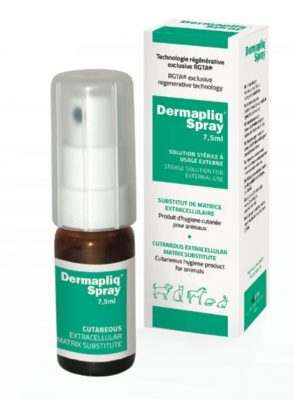Additional information from Dermapliq®
It belongs to the family of regenerating agents (RGTA®), made up of polymers synthesized from biodegradable sugars.
- Sterile solution for external use.
- Easy to use.
- Box containing a 7.5 ml bottle: about 50 sprays.
- Pump 3K® guaranteeing sterility for 6 months
- Preservative free.
Dermapliq® is a therapeutic product based on RGTA® technology.
Dermapliq® protects extracellular matrix proteins to restore the matrix architecture. It preserves the natural cellular micro-environment of the wound and the endogenous factors necessary for tissue regeneration.
The formulation is based on an RGTA® in physiological serum to facilitate wound healing in animals.
